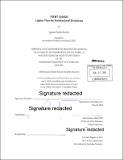EVENT CLOUDS : lighter than air architectural structures
Author(s)
Peydro Duclos, Ignacio
DownloadFull printable version (38.10Mb)
Other Contributors
Massachusetts Institute of Technology. Department of Architecture.
Advisor
Antón Garcia-Abril.
Terms of use
Metadata
Show full item recordAbstract
EVENT CLOUD is a versatile covering system that allows events to happen independently to weather conditions. It consists of a lighter than air pneumatic structure, filled either with helium or hot air, that covers spaces by floating over them. Weightlessness permits EVENT CLOUD to theoretically cover an infinite surface, overcoming traditional large span structures proper weight limitation. EVENT CLOUD is a non-rigid aerodynamic balloon that can act as a fixed roof that does not overload the structure with weight. In this position events are protected from external weather conditions, converting any field into an interior climatically controlled space. If weather conditions are good the covering can be released from the anchoring system and let EVENT CLOUD float on the air. When EVENT CLOUD drifts in the air it becomes an urban reference, a visible object from around the city where the system is placed, and also a local clean energy source for the neighborhood. Creativity and design unite the functionality of a roof, the visual perception of an urban monument and the environmental action of locally producing energy to reduce carbon footprint of large events. EVENT CLOUD defeats gravity by enclosing within its boundaries a gas that weighs less than air to make the whole structure react to the medium it is placed in: air. This type of thinking implies the understanding that architecture creates objects that are inserted into a dynamical system within the fluid of space-time rather than isolated objects that only respond to compositional relations within themselves. Thus the design of EVENT CLOUD implies that architecture is a long-lived art discipline that has evolved from Beaux Arts compositional practices towards the post relativistic art of artificially manipulating the energetic and topological boundaries of events. Weightlessness provides the structure with a higher degree of versatility to allow EVENT CLOUD to nimbly respond to the requirements of each moment in space-time.
Description
Thesis: S.M., Massachusetts Institute of Technology, Department of Architecture, 2014. Cataloged from PDF version of thesis. Includes bibliographical references (pages 86-88).
Date issued
2014Department
Massachusetts Institute of Technology. Department of ArchitecturePublisher
Massachusetts Institute of Technology
Keywords
Architecture.